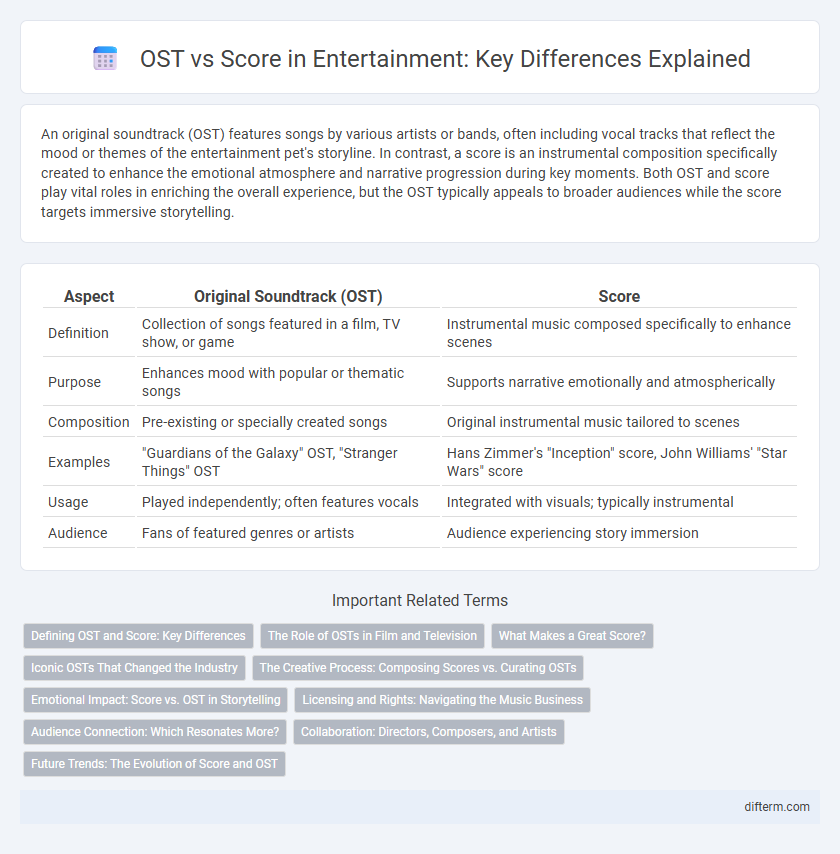An original soundtrack (OST) features songs by various artists or bands, often including vocal tracks that reflect the mood or themes of the entertainment pet's storyline. In contrast, a score is an instrumental composition specifically created to enhance the emotional atmosphere and narrative progression during key moments. Both OST and score play vital roles in enriching the overall experience, but the OST typically appeals to broader audiences while the score targets immersive storytelling.
Table of Comparison
| Aspect | Original Soundtrack (OST) | Score |
|---|---|---|
| Definition | Collection of songs featured in a film, TV show, or game | Instrumental music composed specifically to enhance scenes |
| Purpose | Enhances mood with popular or thematic songs | Supports narrative emotionally and atmospherically |
| Composition | Pre-existing or specially created songs | Original instrumental music tailored to scenes |
| Examples | "Guardians of the Galaxy" OST, "Stranger Things" OST | Hans Zimmer's "Inception" score, John Williams' "Star Wars" score |
| Usage | Played independently; often features vocals | Integrated with visuals; typically instrumental |
| Audience | Fans of featured genres or artists | Audience experiencing story immersion |
Defining OST and Score: Key Differences
An Original Soundtrack (OST) typically features songs created or curated to complement the mood and setting of a film, television show, or video game, often including popular tracks by various artists. In contrast, a score refers to the instrumental music composed specifically to enhance the narrative and emotional impact through thematic motifs and orchestral arrangements. While both OST and score contribute to the overall auditory experience, the OST emphasizes standalone songs, whereas the score is integral to storytelling and scene progression.
The Role of OSTs in Film and Television
Original Soundtracks (OSTs) play a crucial role in film and television by enhancing emotional engagement and reinforcing narrative themes through memorable songs that often become synonymous with the production. Unlike film scores, which primarily consist of instrumental compositions tailored to underscore specific scenes, OSTs frequently include popular tracks that contribute to a production's cultural impact and audience connection. The strategic use of OSTs can elevate storytelling by creating a lasting auditory identity that resonates beyond the screen.
What Makes a Great Score?
A great score enhances the emotional depth of a film by seamlessly integrating with the narrative and emphasizing key moments without overpowering the dialogue or visuals. It uses thematic motifs and instrumentation to create memorable, evocative soundscapes that resonate with the audience long after the movie ends. Unlike an OST, which may feature various licensed songs, a score is meticulously composed to support storytelling and character development.
Iconic OSTs That Changed the Industry
Iconic Original Soundtracks (OSTs) like John Williams' Star Wars and Hans Zimmer's Inception have redefined the entertainment industry by becoming cultural touchstones that transcend their films. These OSTs, characterized by memorable melodies and emotional resonance, often overshadow traditional scores by creating lasting connections with audiences through lyrical and thematic depth. Such groundbreaking soundtracks set new standards in film music, influencing composers and elevating the role of music as a storytelling device in cinema.
The Creative Process: Composing Scores vs. Curating OSTs
Composing scores involves crafting original instrumental music tailored to enhance a film's narrative and emotional depth, requiring close collaboration between composers and directors to align musical themes with storytelling elements. Curating OSTs focuses on selecting existing songs that complement the movie's tone and era, often blending various genres and artists to create a mood that resonates with the audience. Both approaches demand a deep understanding of musical impact, yet scoring prioritizes bespoke composition, while OST curation emphasizes thematic cohesion through pre-existing tracks.
Emotional Impact: Score vs. OST in Storytelling
The score in storytelling intensifies emotional impact by subtly enhancing mood and pacing through instrumental compositions that align closely with on-screen action. OSTs (original soundtracks) often feature vocal tracks or standalone songs that evoke broader emotional responses and linger in viewers' memories beyond the narrative. While scores drive immediate emotional engagement within scenes, OSTs create a lasting cultural and emotional connection tied to the storytelling experience.
Licensing and Rights: Navigating the Music Business
Original Soundtracks (OSTs) often require separate licensing agreements from film scores due to differences in distribution rights and commercial use. Navigating music rights involves understanding synchronization licenses for scores created explicitly for visual media versus master and publishing rights associated with OST tracks by various artists. Proper negotiation and clear contracts ensure legal usage across platforms, protecting creators and distributors in the music business.
Audience Connection: Which Resonates More?
OSTs (Original Soundtracks) often feature memorable songs with lyrics that directly evoke emotions, making them highly effective in forming strong audience connections. Scores, composed of instrumental pieces, subtly enhance the mood and deepen immersion by complementing the narrative without overpowering it. While OSTs resonate through catchy melodies and thematic hooks, scores create lasting emotional impact through intricate orchestration and thematic variations.
Collaboration: Directors, Composers, and Artists
Collaboration between directors, composers, and artists shapes the distinct roles of OST and score in entertainment, with directors guiding the emotional tone while composers create thematic music tailored to narrative moments. Artists contribute through songs featured in the OST that enhance storytelling and audience engagement, often blending popular music styles with cinematic elements. This synergy amplifies the immersive experience by combining original scores with curated tracks that align precisely with the director's vision.
Future Trends: The Evolution of Score and OST
Future trends in entertainment highlight the increasing integration of OSTs and scores, with composers leveraging advanced AI and immersive technologies to craft dynamic, adaptive soundtracks. The evolution of scoring techniques embraces real-time audio manipulation, enhancing player and viewer engagement through personalized auditory experiences. Streaming platforms also drive demand for diverse, genre-blending OSTs that extend narrative immersion beyond traditional media boundaries.
OST vs score Infographic

 difterm.com
difterm.com